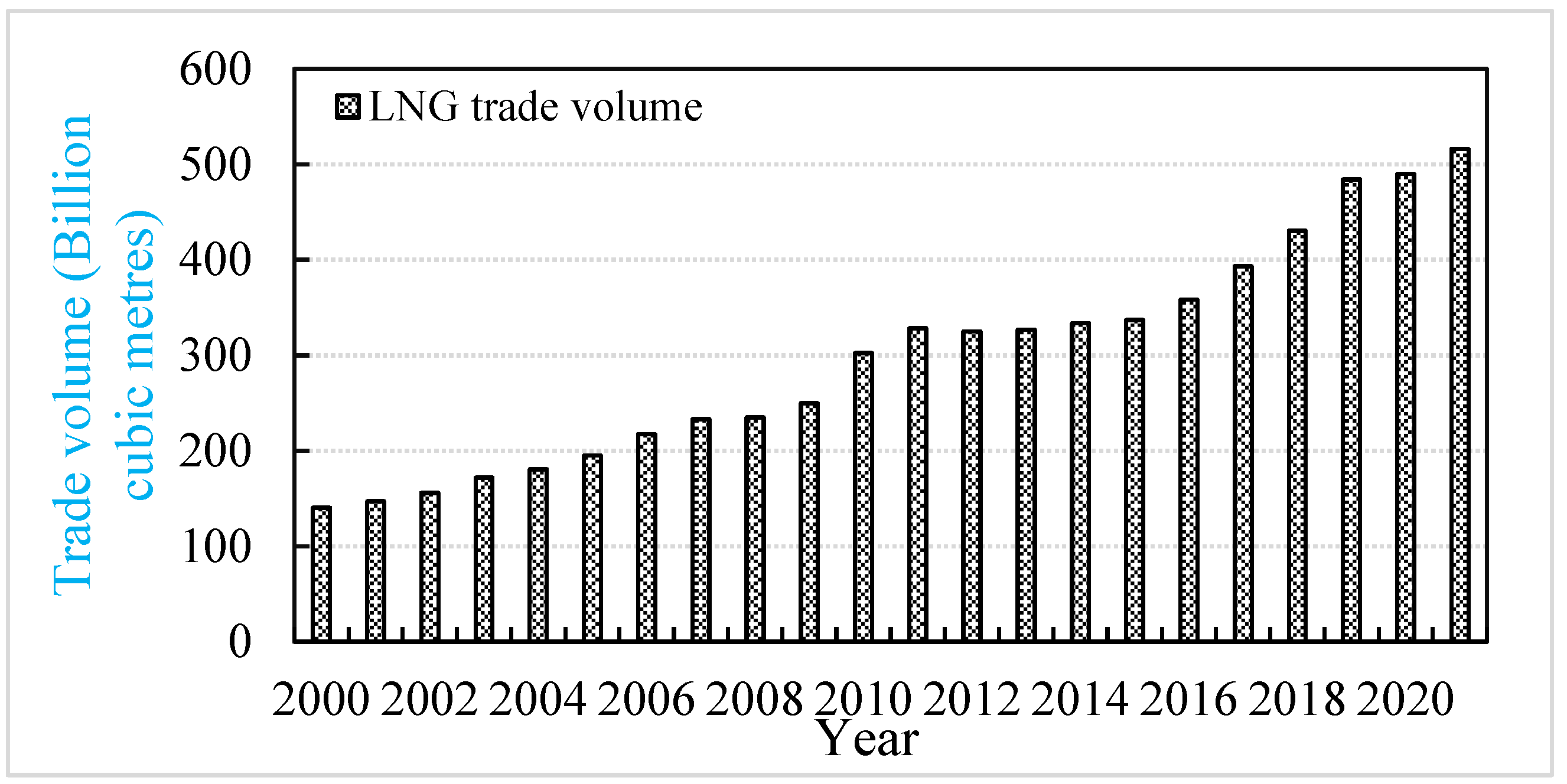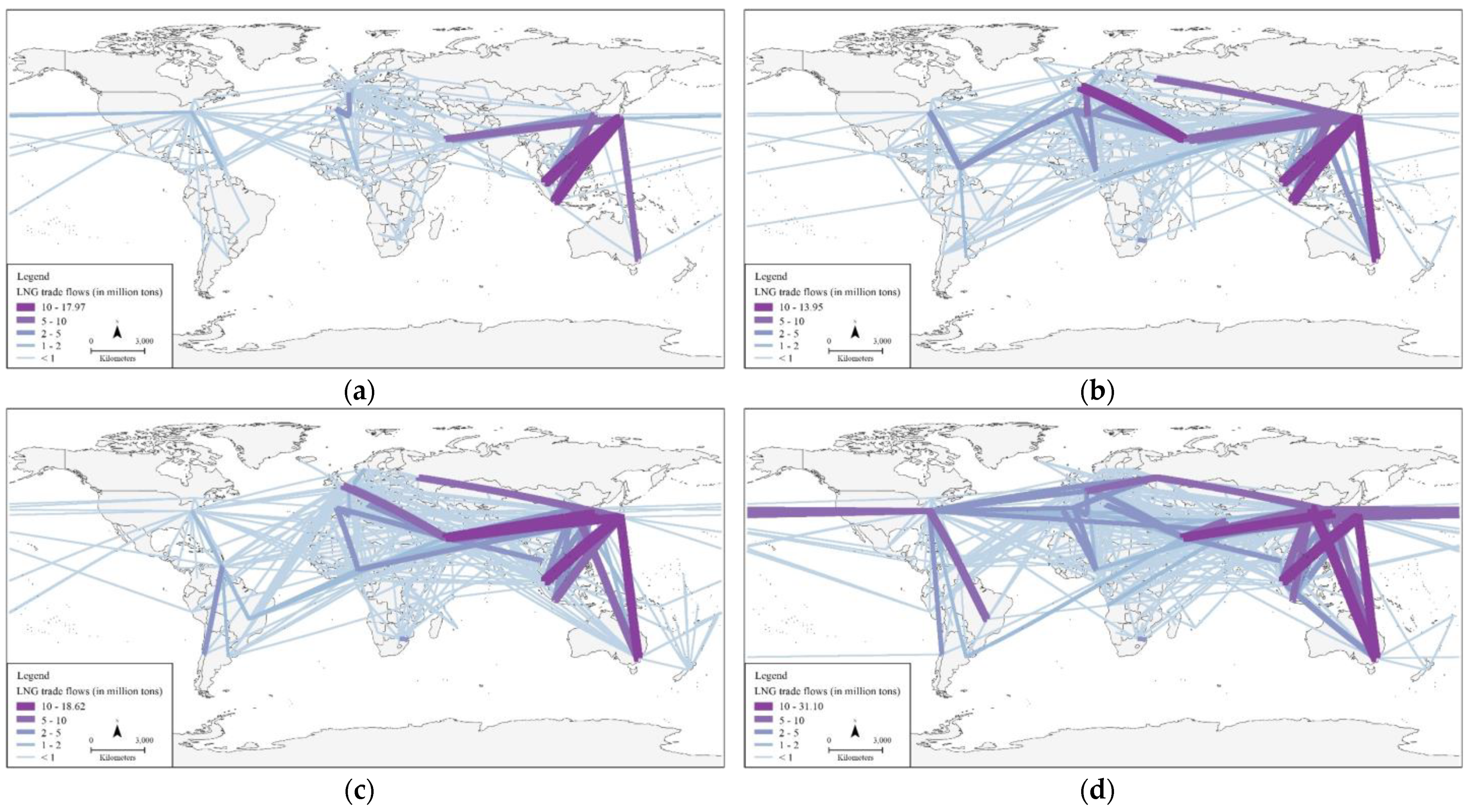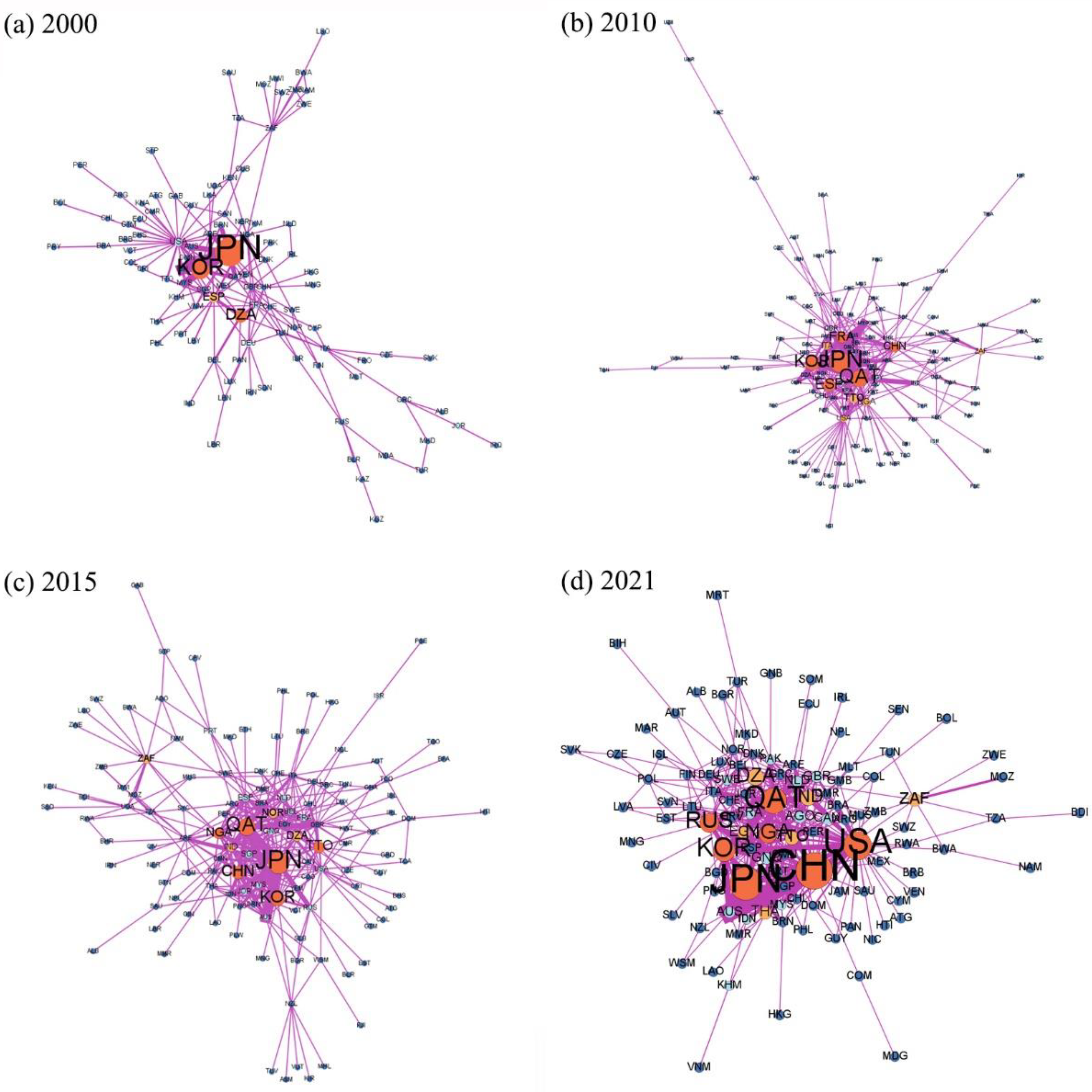Spatiotemporal Evolution and Market Dynamics of the International Liquefied Natural Gas Trade: A Multilevel Network Analysis
Abstract
:1. Introduction
2. Literature Review
3. Materials and Methods
3.1. Data Processing
3.2. Methods
3.2.1. Network Density
3.2.2. Transitivity
3.2.3. Global Efficiency
3.2.4. Weighted Degree Centrality
3.2.5. PageRank Centrality
3.2.6. Core-Periphery Profile
4. Results and Analysis
4.1. Dynamics in Global LNG Trade Volume
4.2. Evolution of Global LNG Trade Patterns
4.3. Topological Properties of Global LNG Trade Networks
4.4. Core-Periphery Evolution of Global LNG Trade Networks
5. Discussion
6. Conclusions
Author Contributions
Funding
Data Availability Statement
Conflicts of Interest
References
- Kober, T.; Schiffer, H.-W.; Densing, M.; Panos, E. Global energy perspectives to 2060—WEC’s World Energy Scenarios 2019. Energy Strat. Rev. 2020, 31, 100523. [Google Scholar] [CrossRef]
- Zou, C.; Zhao, Q.; Zhang, G.; Xiong, B. Energy revolution: From a fossil energy era to a new energy era. Nat. Gas Ind. B 2016, 3, 1–11. [Google Scholar] [CrossRef]
- Raza, M.Y.; Lin, B. Renewable energy substitution and energy technology impact in a transitional economy: A perspective from Pakistan. J. Clean. Prod. 2022, 360, 132163. [Google Scholar] [CrossRef]
- Vivoda, V. Natural gas in Asia: Trade, markets and regional institutions. Energy Policy 2014, 74, 80–90. [Google Scholar] [CrossRef]
- Haddadian, G.; Shahidehpour, M. Ripple Effects of the Shale Gas Boom in the U.S.: Shift in the Balance of Energy Resources, Technology Deployment, Climate Policies, Energy Markets, Geopolitics and Policy Development. Electr. J. 2015, 28, 17–38. [Google Scholar] [CrossRef]
- British Petroleum. Statistical Review of World Energy 2022; British Petroleum: London, UK, 2022. [Google Scholar]
- Thalassinos, E.; Kadłubek, M.; Thong, L.M.; Van Hiep, T.; Ugurlu, E. Managerial Issues Regarding the Role of Natural Gas in the Transition of Energy and the Impact of Natural Gas Consumption on the GDP of Selected Countries. Resources 2022, 11, 42. [Google Scholar] [CrossRef]
- Kumari, N.; Kumar, P.; Sahu, N.C. Do energy consumption and environmental quality enhance subjective wellbeing in G20 countries? Environ. Sci. Pollut. Res. 2021, 28, 60246–60267. [Google Scholar] [CrossRef]
- Le, M.T.; Nguyen, T.T.; Tran, V.H.; Nguyen, T.K.N.; Do, H.T. Can Natural Gas Play an Important Role in the Energy Transition in Asia in the Future? Eurasian J. Bus. Manag. 2019, 7, 28–36. [Google Scholar] [CrossRef]
- Li, R.; Su, M. The Role of Natural Gas and Renewable Energy in Curbing Carbon Emission: Case Study of the United States. Sustainability 2017, 9, 600. [Google Scholar] [CrossRef]
- Shaikh, F.; Ji, Q.; Fan, Y. Assessing the stability of the LNG supply in the Asia Pacific region. J. Nat. Gas Sci. Eng. 2016, 34, 376–386. [Google Scholar] [CrossRef]
- Guo, Y.; Hawkes, A. Simulating the game-theoretic market equilibrium and contract-driven investment in global gas trade using an agent-based method. Energy 2018, 160, 820–834. [Google Scholar] [CrossRef]
- Meza, A.; Ari, I.; Al Sada, M.; Koç, M. Disruption of maritime trade chokepoints and the global LNG trade: An agent-based modeling approach. Marit. Transp. Res. 2022, 3, 100071. [Google Scholar] [CrossRef]
- Meza, A.; Ari, I.; Al-Sada, M.S.; Koç, M. Future LNG competition and trade using an agent-based predictive model. Energy Strat. Rev. 2021, 38, 100734. [Google Scholar] [CrossRef]
- Nikhalat-Jahromi, H.; Fontes, D.B.; Cochrane, R.A. Future liquefied natural gas business structure: A review and comparison of oil and liquefied natural gas sectors. WIREs Energy Environ. 2017, 6, e240. [Google Scholar] [CrossRef]
- Zhang, H.-Y.; Xi, W.-W.; Ji, Q.; Zhang, Q. Exploring the driving factors of global LNG trade flows using gravity modelling. J. Clean. Prod. 2018, 172, 508–515. [Google Scholar] [CrossRef]
- Dashtban Farooji, S.; Dargahi, H. Position of Iran in the International Natural Gas Trade Network: Graph Theory Approach. Iran. J. Energy 2021, 24, 7–42. [Google Scholar]
- Zhong, W.; An, H.; Fang, W.; Gao, X.; Dong, D. Features and evolution of international fossil fuel trade network based on value of emergy. Appl. Energy 2016, 165, 868–877. [Google Scholar] [CrossRef]
- Geng, J.-B.; Ji, Q.; Fan, Y. A dynamic analysis on global natural gas trade network. Appl. Energy 2014, 132, 23–33. [Google Scholar] [CrossRef]
- Barnes, R.; Bosworth, R. LNG is linking regional natural gas markets: Evidence from the gravity model. Energy Econ. 2015, 47, 11–17. [Google Scholar] [CrossRef]
- Li, J.; Dong, X.; Jiang, Q.; Dong, K.; Liu, G. Natural gas trade network of countries and regions along the belt and road: Where to go in the future? Resour. Policy 2021, 71, 101981. [Google Scholar] [CrossRef]
- Yang, Y.; Poon, J.P.; Liu, Y.; Bagchi-Sen, S. Small and flat worlds: A complex network analysis of international trade in crude oil. Energy 2015, 93, 534–543. [Google Scholar] [CrossRef]
- Chen, W.; Zhang, H.; Tang, Z.; Yu, Z. Assessing the structural connectivity of international trade networks along the “Belt and Road”. PLoS ONE 2023, 18, e0282596. [Google Scholar] [CrossRef]
- Wu, G.; Pu, Y.; Shu, T. Features and evolution of global energy trade network based on domestic value-added decomposition of export. Energy 2021, 228, 120486. [Google Scholar] [CrossRef]
- Niu, X.; Chen, W.; Wang, N. Spatiotemporal Dynamics and Topological Evolution of the Global Crude Oil Trade Network. Energies 2023, 16, 1728. [Google Scholar] [CrossRef]
- Mafakheri, A.; Sulaimany, S.; Mohammadi, S. Predicting the establishment and removal of global trade relations for import and export of petrochemical products. Energy 2023, 269, 126850. [Google Scholar] [CrossRef]
- Filimonova, I.V.; Komarova, A.V.; Sharma, R.; Novikov, A.Y. Transformation of international liquefied natural gas markets: New trade routes. Energy Rep. 2022, 8, 675–682. [Google Scholar] [CrossRef]
- Chen, Z.; An, H.; Gao, X.; Li, H.; Hao, X. Competition pattern of the global liquefied natural gas (LNG) trade by network analysis. J. Nat. Gas Sci. Eng. 2016, 33, 769–776. [Google Scholar] [CrossRef]
- Feng, S.; Li, H.; Qi, Y.; Guan, Q.; Wen, S. Who will build new trade relations? Finding potential relations in international liquefied natural gas trade. Energy 2017, 141, 1226–1238. [Google Scholar] [CrossRef]
- Jin, Y.; Yang, Y.; Liu, W. Finding Global Liquefied Natural Gas Potential Trade Relations Based on Improved Link Prediction. Sustainability 2022, 14, 12403. [Google Scholar] [CrossRef]
- Shibasaki, R.; Kanamoto, K.; Suzuki, T. Estimating global pattern of LNG supply chain: A port-based approach by vessel movement database. Marit. Policy Manag. 2020, 47, 143–171. [Google Scholar] [CrossRef]
- Peng, P.; Lu, F.; Cheng, S.; Yang, Y. Mapping the global liquefied natural gas trade network: A perspective of maritime transportation. J. Clean. Prod. 2021, 283, 124640. [Google Scholar] [CrossRef]
- Yan, Z.; He, R.; Yang, H. The small world of global marine crude oil trade based on crude oil tanker flows. Reg. Stud. Mar. Sci. 2022, 51, 102215. [Google Scholar] [CrossRef]
- Fischer, C.S.; Shavit, Y. National differences in network density: Israel and the United States. Soc. Netw. 1995, 17, 129–145. [Google Scholar] [CrossRef]
- Watts, D.J.; Strogatz, S.H. Collective dynamics of ‘small-world’ networks. Nature 1998, 393, 440–442. [Google Scholar] [CrossRef] [PubMed]
- Latora, V.; Marchiori, M. Efficient Behavior of Small-World Networks. Phys. Rev. Lett. 2001, 87, 198701. [Google Scholar] [CrossRef] [PubMed]
- Opsahl, T.; Agneessens, F.; Skvoretz, J. Node centrality in weighted networks: Generalizing degree and shortest paths. Soc. Netw. 2010, 32, 245–251. [Google Scholar] [CrossRef]
- Kiyota, K. The COVID-19 pandemic and the world trade network. J. Asian Econ. 2022, 78, 101419. [Google Scholar] [CrossRef]
- Sajedianfard, N.; Hadian, E.; Samadi, A.H.; Shabani, Z.D.; Sarkar, S.; Robinson, P.A. Quantitative analysis of trade networks: Data and robustness. Appl. Netw. Sci. 2021, 6, 46. [Google Scholar] [CrossRef]
- Chen, W. Delineating the Spatial Boundaries of Megaregions in China: A City Network Perspective. Complexity 2021, 2021, 2574025. [Google Scholar] [CrossRef]
- Della Rossa, F.; Dercole, F.; Piccardi, C. Profiling core-periphery network structure by random walkers. Sci. Rep. 2013, 3, srep01467. [Google Scholar] [CrossRef]
- Ritz, R.A. Price discrimination and limits to arbitrage: An analysis of global LNG markets. Energy Econ. 2014, 45, 324–332. [Google Scholar] [CrossRef]
- Chen, W.; Zhang, H. Characterizing the Structural Evolution of Cereal Trade Networks in the Belt and Road Regions: A Network Analysis Approach. Foods 2022, 11, 1468. [Google Scholar] [CrossRef] [PubMed]
- Chen, Z.; An, H.; An, F.; Guan, Q.; Hao, X. Structural risk evaluation of global gas trade by a network-based dynamics simulation model. Energy 2018, 159, 457–471. [Google Scholar] [CrossRef]
- Kadlubek, M. Supply chain in the strategic approach with the aspects of quality. Int. J. Qual. Res. 2022, 16, 1255–1268. [Google Scholar] [CrossRef]



| Network Description | 2000 | 2010 | 2015 | 2021 |
|---|---|---|---|---|
| Graph size | 174 | 321 | 364 | 404 |
| Network density | 0.0076 | 0.0140 | 0.0158 | 0.0176 |
| Transitivity | 0.1389 | 0.1441 | 0.2514 | 0.2519 |
| Global efficiency | 0.00014 | 0.00021 | 0.00020 | 0.00008 |
| 2000 | 2010 | ||||||
|---|---|---|---|---|---|---|---|
| Country | WDC | Country | PRC | Country | WDC | Country | PRC |
| Japan | 53.69 | USA | 0.0650 | Japan | 70.01 | USA | 0.0881 |
| Indonesia | 24.62 | Italy | 0.0495 | Qatar | 50.92 | Qatar | 0.0880 |
| South Korea | 15.24 | Trinidad and Tobago | 0.0363 | South Korea | 32.67 | United Kingdom | 0.0780 |
| Malaysia | 13.55 | Algeria | 0.0310 | Indonesia | 20.60 | Trinidad and Tobago | 0.0500 |
| Qatar | 9.78 | Germany | 0.0241 | Malaysia | 19.94 | South Africa | 0.0367 |
| Algeria | 9.20 | South Africa | 0.0233 | Spain | 19.27 | Mozambique | 0.0329 |
| Australia | 7.36 | Mozambique | 0.0227 | Australia | 18.23 | Nigeria | 0.0228 |
| Spain | 7.09 | UAE | 0.0160 | Nigeria | 13.91 | Egypt | 0.0215 |
| Brunei | 6.56 | Qatar | 0.0145 | United Kingdom | 13.57 | Algeria | 0.0166 |
| UAE | 5.17 | Kazakhstan | 0.0127 | Algeria | 11.91 | Italy | 0.0164 |
| 2015 | 2021 | ||||||
| Country | WDC | Country | PRC | Country | WDC | Country | PRC |
| Japan | 85.04 | South Africa | 0.0657 | China | 78.79 | USA | 0.1690 |
| Qatar | 64.37 | Mozambique | 0.0608 | Japan | 74.36 | Trinidad and Tobago | 0.1384 |
| South Korea | 33.43 | Qatar | 0.0479 | Australia | 71.43 | South Africa | 0.0352 |
| Australia | 28.22 | Trinidad and Tobago | 0.0404 | Qatar | 63.20 | Mozambique | 0.0318 |
| Malaysia | 24.16 | USA | 0.0329 | United States | 61.51 | Netherlands | 0.0297 |
| China | 19.62 | Norway | 0.0312 | South Korea | 45.97 | Russia | 0.0275 |
| Nigeria | 14.50 | Netherlands | 0.0293 | Russia | 28.70 | Qatar | 0.0257 |
| India | 13.36 | France | 0.0286 | India | 24.54 | China | 0.0231 |
| Indonesia | 13.21 | China | 0.0272 | Malaysia | 24.50 | Australia | 0.0195 |
| Spain | 11.29 | Indonesia | 0.0270 | Spain | 16.11 | Nigeria | 0.0152 |
Disclaimer/Publisher’s Note: The statements, opinions and data contained in all publications are solely those of the individual author(s) and contributor(s) and not of MDPI and/or the editor(s). MDPI and/or the editor(s) disclaim responsibility for any injury to people or property resulting from any ideas, methods, instructions or products referred to in the content. |
© 2023 by the authors. Licensee MDPI, Basel, Switzerland. This article is an open access article distributed under the terms and conditions of the Creative Commons Attribution (CC BY) license (https://creativecommons.org/licenses/by/4.0/).
Share and Cite
Hou, Z.; Niu, X.; Yu, Z.; Chen, W. Spatiotemporal Evolution and Market Dynamics of the International Liquefied Natural Gas Trade: A Multilevel Network Analysis. Energies 2024, 17, 228. https://doi.org/10.3390/en17010228
Hou Z, Niu X, Yu Z, Chen W. Spatiotemporal Evolution and Market Dynamics of the International Liquefied Natural Gas Trade: A Multilevel Network Analysis. Energies. 2024; 17(1):228. https://doi.org/10.3390/en17010228
Chicago/Turabian StyleHou, Zeyu, Xiaoyu Niu, Zhaoyuan Yu, and Wei Chen. 2024. "Spatiotemporal Evolution and Market Dynamics of the International Liquefied Natural Gas Trade: A Multilevel Network Analysis" Energies 17, no. 1: 228. https://doi.org/10.3390/en17010228





